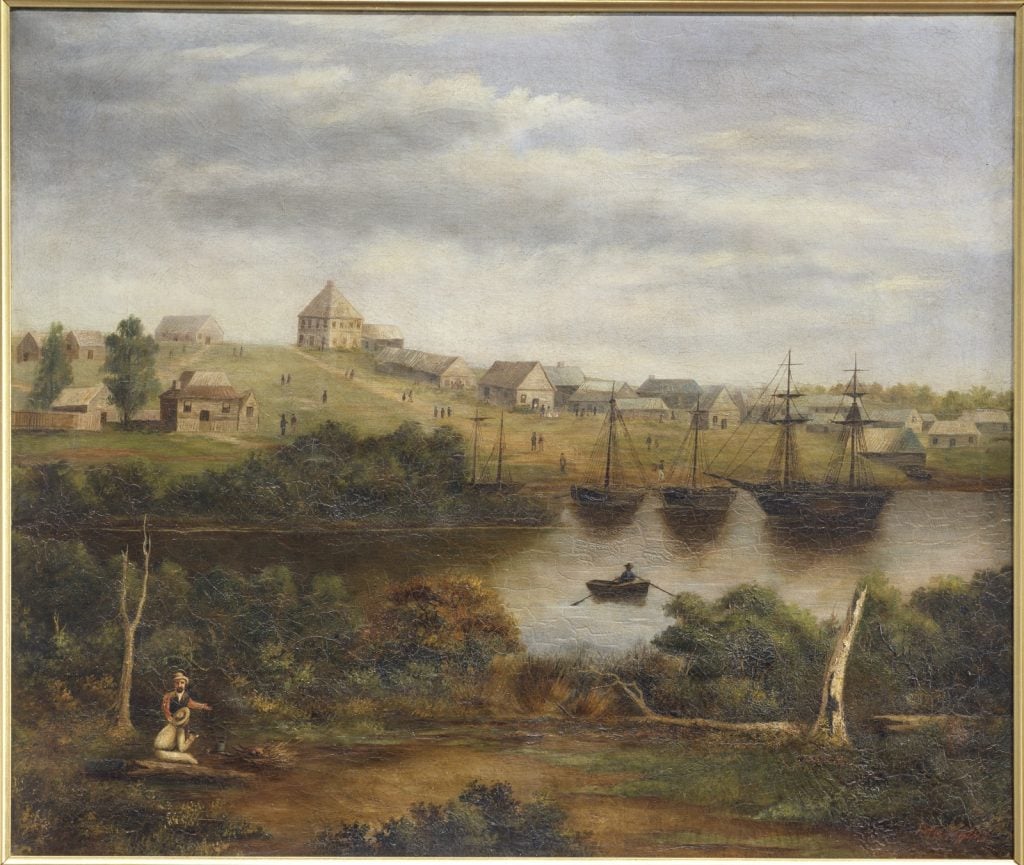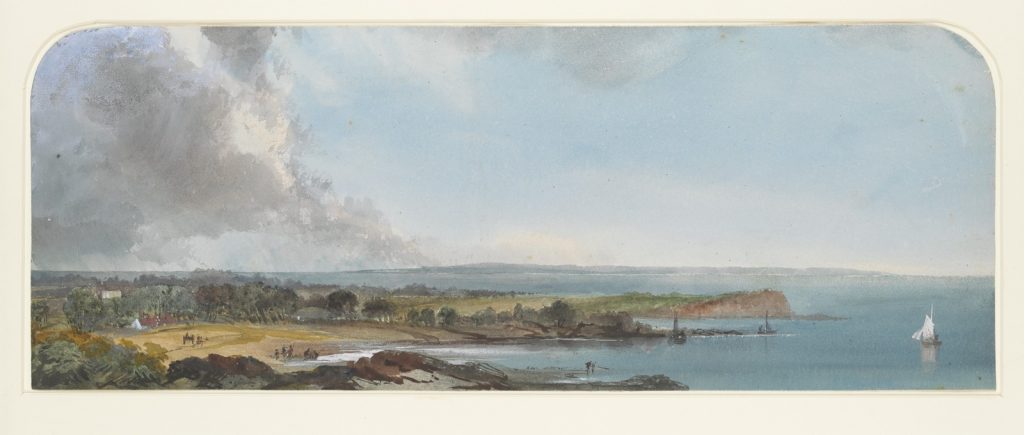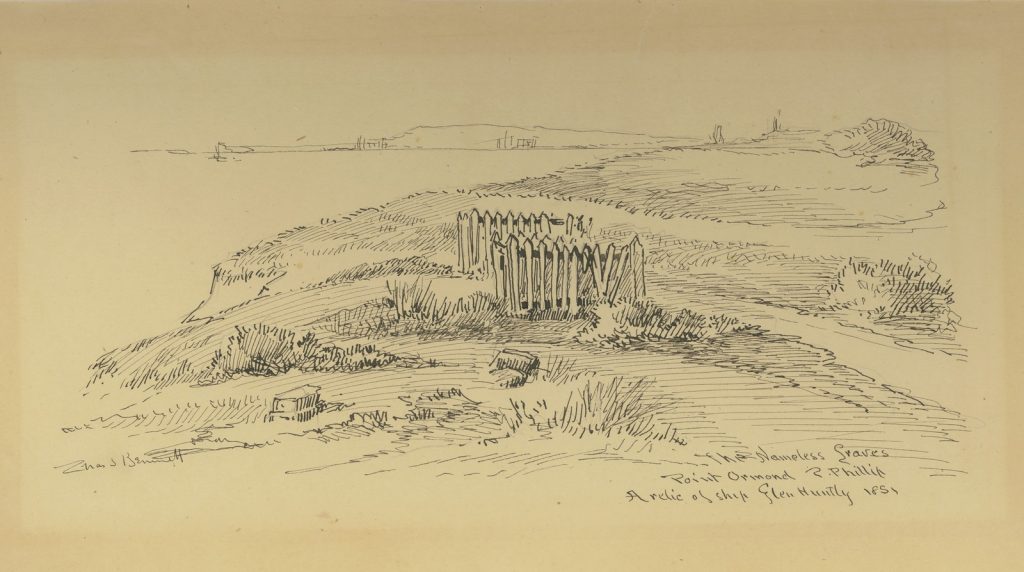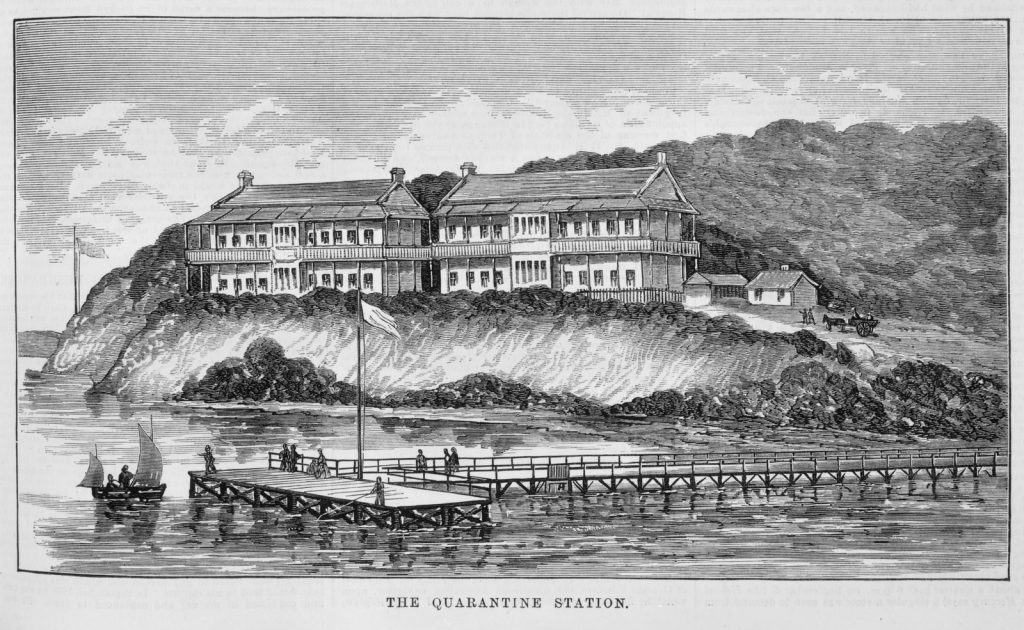
Dr Barry Cotter (Melbourne’s first medical doctor) was preparing to leave for an extended tour of Europe when, in April 1840:
On the eve of his departure the ship Glen Huntly, with typhus passengers, was quarantined at Point Ormond. He at once took charge, and remained on duty until the trouble was over.
Argus (Melbourne, Vic. : 1848 – 1957), Saturday 4 October 1930, page 6
The trouble was to last months.

The Glen Huntly’s arrival was the European colonists of Melbourne’s first major encounter with disease brought by ship. and a quarantine system had to be rapidly implemented.
The first yellow-flagged ship arriving in Port Phillip was the Glen Huntley, from Greenock, with immigrants, on the 17th April 1840. Typhus fever had shown itself on the voyage, and out of 157 passengers there were no less than fifty on the sick list….
… looking out in perpetual watch over Hobson’s Bay, was a point known as the Little Red Bluff, afterwards improved into the Point Ormond, and here some four miles from Melbourne, a pleasant enough spot, was organised our first sanitary station, where tents were pitched and crew and passengers sent ashore.
The chronicles of early Melbourne, 1835 to 1852 : historical, anecdotal and personal. “Garryowen”, 1888, pp 596-597.

This was, remarkably, the second quarantine of the Glen Huntly’s voyage. On leaving Scotland the ship struck a rock – twice – and measles struck during the second repair in Greenwich, resulting in a weeks-long quarantine before departure.

Red Bluff St. Kilda : at present Point Ormond. Painting by Elizabeth Parsons, ca. 1874-ca. 1886; H36676/18
Ten people died aboard the Glen Huntly before it arrived in Victoria, and three died during its quarantine. Another nearly died after a fall from the Little Red Bluff (also known as the Red Bluff). The passengers were divided into “healthy” and “sick” camps, separated from the growing settlement by lagoons and wetlands.
The most significant effect the Glen Huntly’s quarantine had was on the traditional owners of the land that was renamed Elwood, and in fact on all Aboriginal peoples in Melbourne. To the European colonists, the Elwood wetlands were, according to the flawed “miasma” theory of disease, to be feared and avoided. To the Yalukit Willam clan of the Boon Wurrung people, they were a source of life:
The nearby Elwood swamp provided vegetables, wildfowl and eels. The reef which extends from the base of the Point into the sea provided shellfish, fish and crustaceans. Point Ormond was a very important source of seafood as Aboriginal women were visiting there three times per week in the autumn of 1840 to collect shellfish.
Yalukit Willam : The River People of Port Phillip, Eidelson, Meyer, 2014, p 42
It was the visits to harvest shellfish, right alongside the makeshift quarantine station, that Lieutenant-governor La Trobe cited as a reason to expel all Aboriginal camps from Melbourne on April 19, 1840.

The passengers of the Glen Huntly from the “healthy” camp were released on the first of June; the remainder were released, along with Dr Cotter, on the thirteenth. The dead had been buried atop the bluff.

Dr Cotter left, late, on his trip to Europe and returned to Melbourne in 1843. The quarantine station was moved to a more suitable, and distant, location at Point Nepean. The Elwood swamps and wetlands, choked for years on abattoir, stockyard and cesspit runoff, were drained and filled in from the 1880s onwards.

The graves of the Glen Huntly dead were opened and their remains moved to the St Kilda cemetery in 1898. And then, sometime after 1904, the Little Red Bluff was gone, carved up for landfill and lost to the sea.

On the back of this painting is inscribed an extract from Lewis Carroll’s The Walrus and the Carpenter: ‘The sea was wet as wet could be, The sands were dry as dry. You could not see a cloud, because No cloud was in the sky. No birds were flying overhead – There were no birds to fly.’
Further reading
Eidelson, Meyer, 2006, Flood, fire and fever : a history of Elwood
Eidelson, Meyer, 2014, Yalukit Willam : The River People of Port Phillip
McAlister, Moira, 2015, Dr Barry Cotter : the first doctor in Melbourne
Moore, Olive, 1990, Flying the yellow flag : the first voyage of the “Glen Huntley’, 1839-40


This is an informative, beautifully written article including paintings and a historical account of an interesting event. Bringing to life the geographical areas on Point Ormond, St Kilda and Elwood and painting a rich picture in history.
Thankyou Greg.
Thanks for this. Plus ca change plus c’est la meme chose!
Well written. Thank you
How interesting. I live in Caulfield and shop in Glen Huntly road
I knew about this Scottish ship. There is a small plaque outside Woolworths in glen Huntly road!
I know Elwood well and Brighton
Must pass this on
I am Vice President of the Brighton Cemetorians.
Wonderful resources
Be well
Esther
Thank you for the article, as I have a personal connection to the story of the 1840 quarantine station.
My great-great-grandfather and his four sons were passengers on the ship Gen Huntley. My great-great-grandfather was one of the three men who died while in quarantine at Point Ormond and was buried at the site. The images in the article give me a better understanding of what my ancestors would have seen at that time and where the original burial site was located.
It is also ironic that my paternal grandfather died during the 1919 Spanish Flu pandemic.!
Thank you
Alison, my name is Neville Craig and a direct descendent of John Craig who died May 14th at the Quarantine Station at the Red Bluff. In 1990 there were Commemoration events to celebrate the arrival of the G H This was followed by a process to restore the Memorial grave at St Kilda Cemetery. The Commemoration events were well publicised but no-one could find descendants of George Armstrong. If you like to make contact my email address is attached for you to use. Neville Craig, Burwood East.
Neville, hope you receive this. I am am writing a book on my Davidson line, who came on the GH – and all survived. While researching, I learned that my longtime friend’s ancestors were also on board..they were the Armstrongs. Her direct line ended up in SYD. Could you make contact as my friend and I wold be pleased to be in touch. Wendy Wallace Davidson
I too am an ancestor of John Craig and found this a beautifully written, informative article. Neville, do you know anything about John Craig? His siblings, life in Scotland etc? How his wife managed with the children after being widowed?
Alison, am writing a book on my Davidson line, who came on the GH in Apr 1840. While researching, I learned that my longtime friend’s ancestors were also on board..they were the Armstrongs. You are related to my friend. Would like to hear from you if you would care to contact…thanx, Wendy
This is a really interesting article regarding the quarantine practices of Victoria’s first colonists and the dispossession of Aboriginal people of their lands as a byproduct.
What a devastating effect this must have had on the Boon Wurrung tribe.
Just another example of the shameful, disgraceful events in early Australian history, by the ignorant, barbaric colonial government of the time.
I found this article very interesting. My family (Bell, Armstrong and Cameron) came as settlers from Scotland with others from their district on the ship – David Clark in 1839
I have seen historical records of there landing at South Melbourne, describing what they brought with them for their new life, including farm animals. A story of going to a corroboree with local aboriginals. They moved inland to Yarra Glen and set up farming communities with other families. One of the properties is the National trust farm Gulf Station. My 95 year old mother remembers going there as a child for holidays. We have family histories for these families and active family history pages. I think they where gusty to move and resettle in a new land.
Thank you for your info on the Glen Huntly. My ancestor George Armstrong was one of those buried at Red Bluff.
John Craig , my ancestor was also buried at Red Bluff and then moved to St Kilda cemetery. I would be happy to tell you of the Commemoration event held in April 1990 to celebrate the 150th arrival of the Glen Huntly.
Hello Neville
My name is Karen Groeneveld. Also on board the GH were brothers Angus and Donald Craig (my 3x great uncles). In a book titled Darlington, author Florence Charles suggests that John Craig was their brother. However, my Craigs were born in Wick, Caithness and my ‘cousin’ researching our tree does not recognise a brother John. I’d love to clarify this. I suspect it may be coincidence that there were three men with that name on board, but I’ll happily embrace another 3x g uncle if we can establish a connection between the men.
Karen, I am related to Donald and Angus Craig. They were the younger brothers of 2x great grandmother Janet Craig. They had four female siblings but no other brothers.
Coincidentally I am also related to the Glen Huntley John Craig (3x great grandfather) on my father’s side. It seems he was born in Paisley Scotland and is not connected to Donald and Angus.
Interesting to think what Port Phillip bay was originally. Most interesting
Thank you for a very interesting article about Point Ormond. The paintings add interest also.
Lets hope they re-name Glenhuntly (as it is currently sign-posted!) railway station ‘Glen Huntley’ in honour of the memory of the ill-fated ship or at least ‘Glen Huntly’. The metal replica of the ship that was attached to the Safeway store wall was attributed to a Caulfield Technical School classmate named James Sukroo. It was installed in 1990 I believe and removed about 10 years ago due to the Woolworths re-branding. On ‘Trove’, there is an image of the reclaimed Elwood swamp etc., via the ‘Australasian’,Sat.13 Jan, 1906, under the heading: “Elwood Improvements”. P.S: Thanks Greg for the comprehensive story.
Came across this as I am reading Hell Ship by Michael Veith about the Ticonderoga landing in Port Phillip.
Really interesting – thank you.
I too came across this article being prompted to do some research after listening to the audio book “Hell ship”. Very informative article, painting’s really add a lovely touch.
This is really interesting and sad stuff. Sad for the indigenous people who were forced to leave their land. Also sad because of the environmental vandalism of basically carving away what was Little Red Bluff to use as landfill in swampy Elwood.
I was walking around Point Ormond a few days ago. There is a photograph on a plaque (historical marker style), one I hadn’t seen before, that is almost on the crossing (beach side), where you cross Marine Parade near Glen Huntly Road. It’s from 1927 and shows the coastline as well as the tram terminus at the end of Glen Huntly Road. It also shows the old Elwood Pier, which is no longer there.
Thank you for this wonderfully written holistic piece. It is interesting to read about the quarantine system in the age of the pandemic.
I am truly repulsed by the reasoning behind La Trobe’s call for the expulsion of all Aboriginal camps from their own land. And, the systematic destruction of the Elwood swamp and wetlands is so disheartening. A local example of the governance of ignorance and selfishness.
All this has left me wondering why we still have universities, schoolhouses, roads, parks named after barbaric colonists in the same places where Indigenous Australians were inflicted with great pain and generational trauma.
John Craig was my GGG grandfather. I wondered where his wife and family went after disembarking and being released from quarantine.
Hello Pamela,
Thank you for your enquiry. I have lodged your question with our Ask a Librarian service and someone will be in touch soon. With kind regards, Kylie
A very interesting article. I am a descendant of John and Sarah (Wallace) Davidson. Their daughter Margaret is my G G Grandmother.